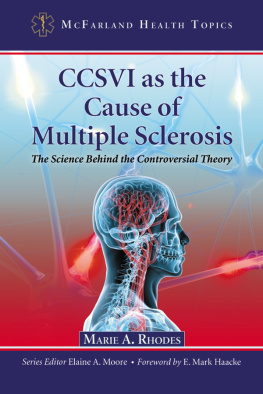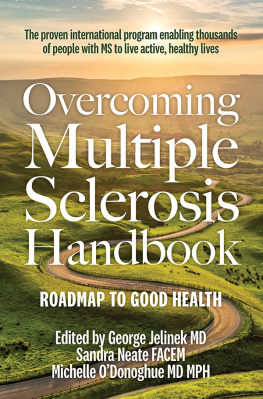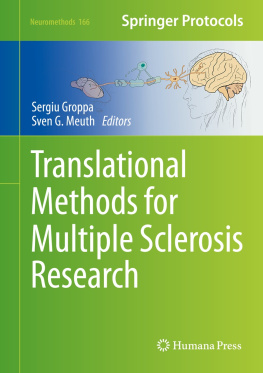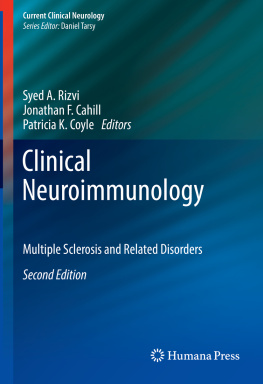Table of Contents
Guide
Page List

Fast Facts: Multiple Sclerosis
First published 2000; second edition 2006; third edition 2014; fourth edition 2016
Fifth edition 2021
Text 2021 Stella E Hughes, Gabrielle Macaron
2021 in this edition S. Karger Publishers Ltd
S. Karger Publishers Ltd, Elizabeth House, Queen Street,
Abingdon, Oxford OX14 3LN, UK
Tel: +44 (0)1235 523233
Book orders can be placed by telephone or email, or via the website.
Please telephone +41 61 306 1440 or email
To order via the website, please go to karger.com
Fast Facts is a trademark of S. Karger Publishers Ltd.
All rights reserved. No part of this publication may be reproduced, stored in a retrieval system, or transmitted in any form or by any means, electronic, mechanical, photocopying, recording or otherwise, without the express permission of the publisher.
The rights of Stella E Hughes and Gabrielle Macaron to be identified as the authors of this work have been asserted in accordance with the Copyright, Designs & Patents Act 1988 Sections 77 and 78.
The publisher and the authors have made every effort to ensure the accuracy of this book, but cannot accept responsibility for any errors or omissions.
For all drugs, please consult the product labeling approved in your country for prescribing information.
Registered names, trademarks, etc. used in this book, even when not marked as such, are not to be considered unprotected by law.
A CIP record for this title is available from the British Library.
ISBN 978-3-318-06797-2
Hughes SE (Stella)
Fast Facts: Multiple Sclerosis/
Stella E Hughes, Gabrielle Macaron
Medical illustrations by Annamaria Dutto, Withernsea, UK.
Typesetting by Amnet, Chennai, India.
Printed in the UK with Xpedient Print.
Contents
9-HPT: 9-hole peg test
AAN: American Academy of Neurology
ACTH: adrenocorticotropic hormone
ADEM: acute disseminated encephalomyelitis
ADL: activities of daily living
AHSCT: autologous hematopoietic stem cell transplantation
AQP-4: aquaporin 4
bd: twice daily
CIS: clinically isolated syndrome
CNS: central nervous system
CSF: cerebrospinal fluid
CT: computed tomography
DHODH: dihydroorotate dehydrogenase
DIS: dissemination in space
DIT: dissemination in time
DMT: disease-modifying therapy
EAN: European Academy of Neurology
EBV: EpsteinBarr virus
ECTRIMS: European Committee of Treatment and Research in Multiple Sclerosis
EDSS: Expanded Disability Status Scale
EMA: European Medicines Agency
FDA: (US) Food and Drug Administration
FLAIR: fluid-attenuated inversion recovery
HLA: human leukocyte antigen
IFN-: interferon-beta
IgG: immunoglobulin G
IL: interleukin
INO: internuclear ophthalmoplegia
IPMSSG: International Pediatric Multiple Sclerosis Study Group
i.v.: intravenous
JC: John Cunningham (virus)
MHC: major histocompatibility complex
MOG: myelin oligodendrocyte glycoprotein
MRI: magnetic resonance imaging
MS: multiple sclerosis
MSFC: Multiple Sclerosis Functional Composite
MSN: multiple sclerosis specialist nurse
NEDA: no evidence of disease activity
NMO: neuromyelitis optica
NMOSD: neuromyelitis optica spectrum disorder
Nrf2: nuclear factor (erythroid-derived 2)-like 2
PCR: polymerase chain reaction
PEG: percutaneous enteral gastrostomy
PLEX: plasma exchange
PML: progressive multifocal leukoencephalopathy
POMS: pediatric-onset multiple sclerosis
PPMS: primary progressive multiple sclerosis
PRMS: progressive relapsing multiple sclerosis
RCT: randomized controlled trial
RIS: radiologically isolated syndrome
RRMS: relapsing remitting multiple sclerosis
S1P: sphingosine 1-phosphate
SDMT: Symbol Digit Modalities Test
SLE: systemic lupus erythematosus
SNRI: serotoninnorepinephrine reuptake inhibitor
SPMS: secondary progressive multiple sclerosis
STIR: short time inversion recovery
T25FW: timed 25-foot walk
TKI: tyrosine kinase inhibitor
TNF: tumor necrosis factor
UTI: urinary tract infection
UV: ultraviolet (light)
VCAM1: vascular cell adhesion molecule-1
WHO: World Health Organization
Multiple sclerosis (MS) is a leading cause of disability in young adults, and it has a significant effect on patients quality of life, family plans and careers. By causing varying degrees of physical and cognitive disability, MS carries a considerable individual and societal economic burden.
Fortunately, we are entering a new era in the management of MS. Several recent studies support initiating treatment early in the disease course with higher-efficacy disease-modifying therapies in patients with relapsing-remitting MS. This approach has been associated with better long-term outcomes, specifically a lower risk of conversion to secondary progressive MS. Moreover, new molecules with the potential to induce myelin repair or halt the neurodegenerative process are in the pipeline for the treatment of progressive MS. Coupled with a recent update to the diagnostic criteria, clinicians can now diagnose and treat patients in the earliest phases of their disease.
In this new edition of Fast Facts: Multiple Sclerosis, we present the latest evidence on disease pathogenesis and all clinical aspects of the condition, as well as the latest on disease-modifying therapies and other potential treatments.
Given the need for multidisciplinary management of MS, we have written this resource for the benefit of all health professionals involved in the care of patients with this complex disease.
Acknowledgments. The authors wish to thank the authors of the third and fourth editions of this resource, Drs Michael Barnett, Omar Malik, Ann Donnelly, Mary Rensel and Orla Gray, for the strong foundation on which this new edition is based.
Multiple sclerosis (MS) is a neurological condition resulting from inflammation and degeneration within the central nervous system (CNS). This inflammation can affect different sites at different times, producing a variety of symptoms and signs. Periods of relapse and remission occur in the early stages of the disease, and in most patients a slowly progressive course ensues within one to two decades of disease onset. The cause of MS is unknown, but dysregulation of the immune system is central to the pathogenesis of the disease.
Epidemiology
MS is the leading cause of neurological disability in the young and middle-aged populations of the developed world. Survey figures from 2020 suggest that it affects 2.8 million people worldwide. Given the lack of complete surveillance data in some countries, this is likely to be an underestimate.















